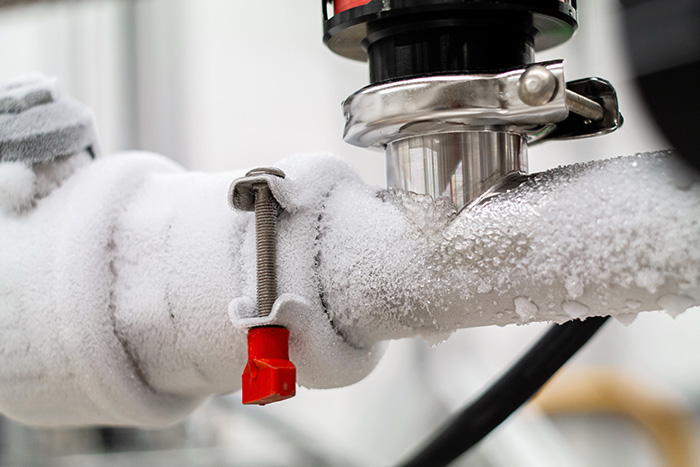Protecting Pipes from Freezing Issues: Critical Strategies
Protecting Pipes from Freezing Issues: Critical Strategies
Blog Article
Nearly everybody is bound to have their private perception involving Preventing and dealing with frozen pipes.
:strip_icc()/snow-outdoor-faucet-pipes-4af65d1e5e904fb1aa7bf74071fe5d89.jpg)
Winter can ruin your pipes, especially by freezing pipelines. Right here's exactly how to avoid it from happening and what to do if it does.
Intro
As temperature levels decrease, the risk of icy pipelines boosts, potentially leading to pricey repair services and water damage. Recognizing exactly how to prevent frozen pipes is important for property owners in cold climates.
Understanding Frozen Pipes
What causes pipes to ice up?
Pipes ice up when exposed to temperature levels listed below 32 ° F (0 ° C) for extended durations. As water inside the pipelines freezes, it increases, taxing the pipe wall surfaces and potentially creating them to rupture.
Dangers and problems
Icy pipes can cause water system disruptions, residential or commercial property damages, and expensive fixings. Burst pipelines can flood homes and create comprehensive architectural damage.
Indications of Frozen Piping
Identifying frozen pipelines early can stop them from bursting.
Exactly how to identify frozen pipelines
Try to find reduced water flow from faucets, unusual odors or sounds from pipelines, and noticeable frost on subjected pipes.
Avoidance Tips
Protecting susceptible pipes
Cover pipelines in insulation sleeves or utilize heat tape to shield them from freezing temperature levels. Focus on pipes in unheated or external areas of the home.
Heating techniques
Maintain interior spaces adequately heated up, especially locations with plumbing. Open up cupboard doors to allow cozy air to distribute around pipelines under sinks.
Securing Outdoor Pipes
Yard hose pipes and outside faucets
Disconnect and drain pipes yard hoses prior to winter season. Mount frost-proof spigots or cover outside taps with insulated caps.
What to Do If Your Pipelines Freeze
Immediate actions to take
If you think icy pipelines, keep faucets open to ease stress as the ice thaws. Use a hairdryer or towels soaked in hot water to thaw pipelines gradually.
Long-Term Solutions
Architectural changes
Consider rerouting pipes far from outside wall surfaces or unheated locations. Include additional insulation to attic rooms, cellars, and crawl spaces.
Updating insulation
Purchase high-grade insulation for pipelines, attics, and wall surfaces. Correct insulation aids keep regular temperature levels and minimizes the danger of frozen pipes.
Verdict
Protecting against icy pipelines needs proactive measures and fast actions. By comprehending the causes, indicators, and preventive measures, homeowners can shield their pipes during cold weather.
5 Ways to Prevent Frozen Pipes
Drain Outdoor Faucets and Disconnect Hoses
First, close the shut-off valve that controls the flow of water in the pipe to your outdoor faucet. Then, head outside to disconnect and drain your hose and open the outdoor faucet to allow the water to completely drain out of the line. Turn off the faucet when done. Finally, head back to the shut-off valve and drain the remaining water inside the pipe into a bucket or container. Additionally, if you have a home irrigation system, you should consider hiring an expert to clear the system of water each year.
Insulate Pipes
One of the best and most cost-effective methods for preventing frozen water pipes is to wrap your pipes with insulation. This is especially important for areas in your home that aren’t exposed to heat, such as an attic. We suggest using foam sleeves, which can typically be found at your local hardware store.
Keep Heat Running at 65
Your pipes are located inside your walls, and the temperature there is much colder than the rest of the house. To prevent your pipes from freezing, The Insurance Information Institute suggests that you keep your home heated to at least 65 degrees, even when traveling. You may want to invest in smart devices that can keep an eye on the temperature in your home while you’re away.
Leave Water Dripping
Moving water — even a small trickle — can prevent ice from forming inside your pipes. When freezing temps are imminent, start a drip of water from all faucets that serve exposed pipes. Leaving a few faucets running will also help relieve pressure inside the pipes and help prevent a rupture if the water inside freezes.
Open Cupboard Doors
Warm your kitchen and bathroom pipes by opening cupboards and vanities. You should also leave your interior doors ajar to help warm air circulate evenly throughout your home.

I stumbled upon that content about Winter Plumbing Precautions: Preventing Frozen Pipes while perusing the web. For those who appreciated our blog entry if you please remember to pass it around. Thank you so much for your time invested reading it.
Call Today Report this page